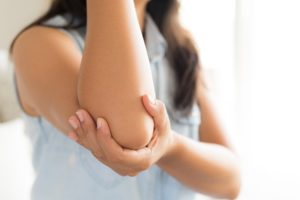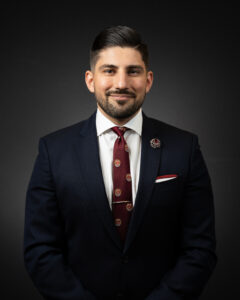Elbow Pain Treatment & Orthopedic Care

Elbow pain is common and often results from repetitive arm, hand, or wrist movements, such as those involved in swinging a tennis racquet, golf club, or baseball bat. In addition to overuse injuries like medial epicondylitis (golfers elbow) or lateral epicondylitis (tennis elbow), elbow pain can result from arthritis or trauma, such as a direct blow or a fall that causes a muscle strain, ligament sprain, bone fracture, or joint dislocation.
Suppose elbow pain is interfering with your daily activities. In that case, you can consult a specialist at Advanced Orthopedics and Sports Medicine Institute in Freehold or Monroe Township, New Jersey. At our state-of-the-art facilities, you can receive a prompt diagnosis of the cause of your elbow pain and an individualized treatment plan. Our experts can help you feel better faster.
Elbow Pain and Injury Diagnostic Process at AOSMI
An accurate diagnosis is critical to finding effective and lasting relief from elbow pain. To identify the source of your discomfort, an orthopedic joint specialist at AOSMI will review your symptoms, discuss your medical history, and perform a physical examination. The diagnostic process may include imaging, such as an X-ray or MRI scan, to help your physician evaluate the bones and soft tissues in and around your elbow. When appropriate, our board-certified orthopedic surgeons can perform arthroscopic surgery to diagnose (and treat) osteochondral defects, such as microfractures and lesions in the elbow joint
Elbow Pain Treatment Options
At AOSMI, we offer a full range of conservative and surgical treatment options for elbow pain and emphasize nonsurgical treatment whenever possible. We often suggest that our patients begin with the PRICE protocol, which involves the following:
- Protecting the elbow with a brace or cast to help prevent further damage
- Resting and avoiding activities that worsen the pain
- Icing the inflamed area to reduce swelling
- Compressing the elbow with an elastic bandage
- Elevating the arm above the heart level
If needed, over-the-counter nonsteroidal anti-inflammatory drugs (NSAIDs) can help reduce painful inflammation in the elbow. If appropriate, we may discuss injections, orthobiologics, or surgery, such as an open reduction and internal fixation to address an elbow fracture or an incision and drainage to address severe bursitis or an infected bursa in the elbow.
Once elbow pain improves, a gradual return to activity is best. Many people begin by practicing the arm motions involved in their sport. For instance, a golf instructor can assess a golf swing to confirm the correct technique.
If you’d like to discuss your elbow pain with an expert at AOSMI, contact us to schedule an appointment at our Freehold or Monroe Township, NJ office.
FREQUENTLY ASKED QUESTIONS ABOUT ELBOW PAIN
Q: What is the difference between golfer’s elbow and tennis elbow?
A: Golfer’s elbow, medically known as medial epicondylitis, is a condition characterized by pain and inflammation on the inner side of the elbow. It is typically caused by repetitive motions or excessive gripping activities, often seen in golfers, but can also occur in other sports or activities. Tennis elbow, medically known as lateral epicondylitis, is a condition characterized by pain and inflammation on the outer side of the elbow. It is caused by repetitive wrist extension and gripping, classically seen in tennis players, but also commonly seen with many other activities. While the location of pain differs, both conditions are forms of tendonitis and involve inflammation of the tendons in the elbow.
Q: Can elbow pain be treated without surgery?
A: Yes, in most cases, elbow pain can be effectively treated without surgery. Non-surgical treatment options for elbow pain may include:
- Rest: Avoiding activities that aggravate the pain and allowing the elbow to rest and heal.
- Physical therapy: Strengthening and stretching exercises can help improve flexibility, reduce pain, and enhance overall function.
- Medications: Nonsteroidal anti-inflammatory drugs (NSAIDs), such as ibuprofen, may be recommended to manage pain and inflammation.
- Orthotics or braces: Wearing a brace or splint can provide support, reduce strain, and promote healing.
- Steroid injections: Corticosteroid injections into the affected area may help reduce inflammation and provide temporary relief.
- Activity modification: Adjusting or modifying activities to avoid repetitive motions or actions that exacerbate the pain.
- Heat or ice therapy: Applying heat or ice to the affected area can help reduce pain and inflammation.
Surgery is typically considered if conservative treatments fail to alleviate symptoms or in cases of severe injuries or conditions that require urgent surgical intervention.
Q: What are common causes of elbow pain?
A: Elbow pain can have various causes, including:
- Tendinitis: Inflammation of the tendons, such as in golfer’s elbow or tennis elbow.
- Overuse injuries: Repetitive motions and activities that strain the muscles and tendons around the elbow joint.
- Trauma or injury: Fractures, dislocations, sprains, or strains resulting from falls, accidents, or sports-related activities.
- Arthritis: Conditions like osteoarthritis or rheumatoid arthritis can cause pain and inflammation in the elbow joint.
- Nerve compression: Pinched nerves, such as cubital tunnel syndrome or radial tunnel syndrome, can lead to elbow pain.
- Bursitis: Inflammation of the bursae, fluid-filled sacs that cushion the joint, can cause elbow pain.
Q: What causes elbow pain without injury?
A: Elbow pain without a specific injury can occur due to various factors, including:
- Overuse or repetitive strain: Engaging in activities that involve repetitive motions or placing excessive strain on the elbow joint over time.
- Arthritis: Degenerative conditions like osteoarthritis or inflammatory conditions like rheumatoid arthritis can cause elbow pain.
- Nerve compression: Compression or irritation of the nerves around the elbow, such as ulnar nerve compression, can lead to pain.
- Tendinopathy: Degeneration or breakdown of the tendons around the elbow, without a specific traumatic event, can cause pain.
- Radial tunnel syndrome: A condition characterized by compression of the radial nerve, resulting in elbow pain.
Q: How do I know if my elbow pain is serious?
A: While it’s always important to consult with a healthcare professional for a proper evaluation, certain signs and symptoms associated with elbow pain may indicate a more serious condition or injury. These include:
- Severe pain or inability to move the elbow joint.
- Visible deformity or misalignment of the elbow.
- Intense swelling, bruising, or redness around the elbow.
- Numbness, tingling, or weakness in the arm or hand.
- Fever or signs of infection, such as warmth and redness.
Find your Provider



 Alan S. Nasar, MD, FAAOS
Alan S. Nasar, MD, FAAOS










